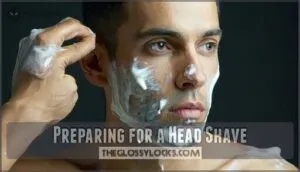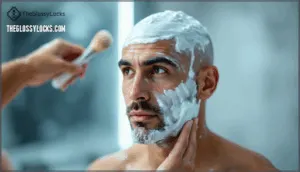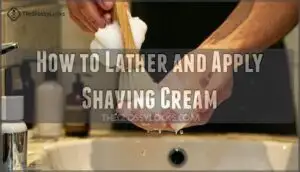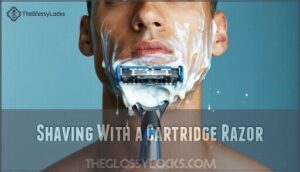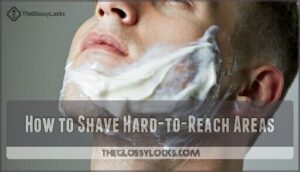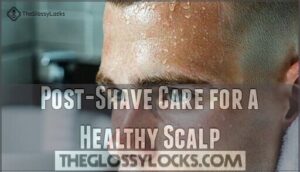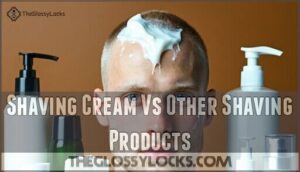This site is supported by our readers. We may earn a commission, at no cost to you, if you purchase through links.
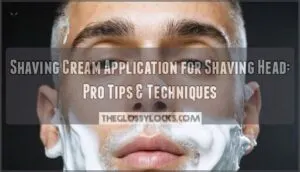
Work the cream into a rich lather that covers your entire head evenly. Don’t rush this step – proper coverage prevents nicks and irritation.
The cream should feel slick and protective, not thin or patchy. Focus extra attention on areas where hair grows in different directions.
Once you’ve achieved complete coverage with a thick, cushioning layer, you’re ready to shave. Getting this foundation right makes all the difference between a comfortable shave and a painful experience.
Table Of Contents
- Key Takeaways
- Preparing for a Head Shave
- Choosing The Right Shaving Cream
- Applying Shaving Cream for a Head Shave
- Shaving Techniques for a Smooth Head Shave
- Post-Shave Care for a Healthy Scalp
- Shaving Cream Vs Other Shaving Products
- Common Mistakes to Avoid When Shaving Your Head
- Maintaining a Healthy Scalp With Regular Shaving
- Frequently Asked Questions (FAQs)
- Should I use shaving cream when shaving my head?
- Is it better to shave head hair wet or dry?
- What to put on a shaved head after shaving?
- What is the 3:1:1 rule for shaving cream?
- How do you shave your head with shaving cream?
- Can shaving cream be used on the head?
- Should I use shaving cream with head shaver?
- What do you put on your head before shaving?
- How often should I reapply shaving cream while shaving head?
- Are there any natural alternatives to commercial shaving creams available?
- Conclusion
Key Takeaways
- Start with proper prep work – You’ll get better results when you soften hair with warm water for 5 minutes and gently exfoliate your scalp before applying any cream.
- Apply cream methodically for complete coverage – Use a quarter-sized amount and work it into a rich, thick lather using circular motions with your fingers or a shaving brush, ensuring every area is protected.
- Choose quality cream with protective ingredients – Look for formulas containing natural moisturizers like glycerin, aloe vera, and chamomile that create a slick barrier and prevent razor burn.
- Follow up with proper post-shave care – Rinse with cold water to close pores, then immediately apply an alcohol-free moisturizer or balm to prevent irritation and maintain scalp health.
Preparing for a Head Shave
Getting your scalp ready for shaving isn’t just about slapping on some cream and hoping for the best.
Proper preparation makes the difference between a smooth, comfortable shave and a face full of razor burn that’ll have you looking like an angry tomato.
Importance of a Shaving Routine
The right shaving routine transforms head shaving from a chore into mastery.
Consistent shave prep builds efficiency and prevents irritation while promoting scalp health.
Benefits of establishing your shaving routine:
- Efficiency gains – Streamlined shave prep reduces time and effort
- Better results – Regular hair softening creates smoother shaves
- Reduced irritation – Consistent technique prevents razor burn
- Blade longevity – Proper maintenance extends razor life
- Scalp health – Regular shave frequency maintains skin condition
Tips for Pre-Shave Preparation
Since proper Pre-Shave Prep sets the foundation for your Shaving Routine, start with warm water preparation and Scalp Massage techniques.
| Preparation Step | Duration | Purpose |
|---|---|---|
| Warm water soak | 5 minutes | Opens pores, softens hair |
| Scalp Massage | 2-3 minutes | Increases blood flow, relaxes follicles |
| Warm towel wrap | 3-5 minutes | Hair Softening, preparation |
| Scalp Exfoliation | 1-2 minutes | Removes dead skin, prevents ingrowns |
This systematic approach transforms tough stubble into manageable hair, making your shaving cream application more effective and comfortable.
Exfoliating and Softening Hair
Preparation is everything in achieving that perfect head shave. Start your pre-shave routine by taking control of your scalp’s condition through proper exfoliating techniques and hair softening methods.
Begin with a scalp massage using circular motions to boost blood circulation and loosen dead skin cells. This simple step prevents ingrown hairs while preparing your skin for a smoother shave. Next, focus on hair softening by soaking your head in warm water for five minutes or applying a warm, damp towel.
Here’s your step-by-step approach:
- Exfoliate with gentle scrubs or exfoliating gloves to remove buildup
- Soften hair follicles using warm water or steam
- Massage your scalp to increase blood flow and reduce tension
- Prepare hard-to-reach areas with extra attention to prevent irritation
This ingrown prevention strategy sets the foundation for safe shaving head techniques and ideal shaving cream application. Effective pre shave preparation is vital for achieving a smooth and comfortable head shave.
Choosing The Right Shaving Cream
You’ll need the right shaving cream to transform your head shaving routine from a rough ordeal into a smooth, comfortable experience.
The cream you choose determines whether you’ll walk away with baby-soft skin or spend the day dealing with razor burn and irritation.
Ingredients to Look for in Shaving Cream
Your cream’s ingredient list determines whether you’ll get a smooth shave or a scalp disaster.
Seek out natural moisturizers like coconut oil and glycerin that create protective barriers. Soothing agents such as aloe vera and chamomile calm irritation, while anti irritants prevent razor burn.
Quality lubricants guarantee your blade glides effortlessly across your scalp.
When choosing a shaving cream, be aware of the potential harmful ingredients that can cause skin irritation and other health issues.
Benefits of Using Shaving Cream for Head Shaves
Quality shaving cream transforms your head-shaving experience. It creates a protective barrier between your razor and scalp, delivering superior shave quality and skin protection. This moisture lock technology softens hair while providing excellent razor glide.
Here’s what shaving cream application delivers:
- Enhanced Shaving Comfort – Reduces friction and prevents nicks during each pass
- Superior Razor Performance – Lubricates blades for smoother cutting action
- Scalp Health Protection – Maintains skin moisture and prevents irritation
Head shaving cream isn’t just luxury—it’s practical protection for shaving head safely.
Applying Shaving Cream for a Head Shave
Proper shaving cream application makes the difference between a smooth, comfortable head shave and an irritating experience that leaves your scalp red and bumpy.
You’ll master the art of creating rich lather, applying it evenly across your scalp, and using the right techniques to achieve professional-quality results at home.
How to Lather and Apply Shaving Cream
Start with an almond-sized dollop of head shaving cream on your palm. Work the cream application into a rich shaving cream lather using circular motions.
Your shaving brush creates superior lather techniques – soak it in warm water for thirty seconds first. Apply the lather across your scalp with upward strokes, ensuring complete coverage.
This razor prep step reduces friction and protects your skin during the shave. To achieve the best results, consider using a shaving cream guide for ideal skin protection and a smooth shave.
Tips for Shaving With The Grain
Once you’ve applied your shaving cream evenly, following the grain direction becomes your roadmap to irritation-free results.
Shaving with the grain means moving your razor in the same direction your hair naturally grows, which varies across different areas of your head.
- Map your grain direction – Run your hand across dry scalp before shaving to feel which way hair naturally lies
- Maintain proper shave angle – Keep your razor at 30-45 degrees against skin for ideal cutting
- Choose your razor wisely – Cartridge razors work best for beginners, while experienced shavers prefer double-edge options
- Prep each section differently – Hair texture changes around your head, so adjust pressure and technique accordingly
Understanding lather creation techniques is essential for a smooth shave.
Using a Shaving Brush for a Closer Shave
Elevate your head shaving game with a quality shaving brush that transforms ordinary shaving cream application into professional-grade shave prep.
The brush creates superior lather creation while gently exfoliating your scalp for ideal results.
Here’s how a shaving brush enhances your shaving head care routine:
- Enhanced Lather Creation: The bristles whip shaving cream into rich, warm foam that provides better lubrication than hand application alone.
- Improved Shave Prep: Brush movements lift hair follicles upward, allowing your razor to catch stubborn hairs that lie flat against your scalp.
- Better Brush Care: Quality handle materials like wood or metal last years when properly maintained, making this investment worthwhile for regular head shavers.
Shaving Techniques for a Smooth Head Shave
Once you’ve applied your shaving cream properly, you’ll need to master the right techniques to achieve that perfectly smooth dome.
The key lies in choosing the right razor type and learning how to navigate those tricky spots that seem impossible to reach.
Shaving With a Cartridge Razor
Cartridge razors offer your best shot at mastering head shaving without years of practice.
The quickest path from scalp novice to smooth-headed pro starts with the right razor.
Choose a razor with multiple blades and a pivoting head that follows your skull’s natural curves.
Apply your shaving head cream generously, then hold the razor at a 30-degree angle.
Shave with the grain using light, controlled strokes—let the blade do the work.
| Cartridge Types | Best Features |
|---|---|
| Pivoting head | Follows head contours naturally |
| Fixed head | Maximum control and precision |
| Multi-blade | Closer shave in fewer passes |
Your razor handle should feel comfortable in wet hands.
Focus proper shave angle over speed—rushing leads to nicks.
For razor maintenance, rinse frequently during use and replace blades every 5-7 shaves.
Sharp blades paired with quality shaving cream application create smooth results every time.
Using a Straight or Double-Edge Razor
Razor Maintenance starts with keeping your straight razor or double-edge razor spotless. Clean blades after each pass.
Blade Sharpening through regular stropping maintains your edge’s bite. Hold your razor at thirty degrees against your scalp.
Safety Precautions mean light pressure and short strokes. Razor Handling requires steady hands – stretch skin taut with your free hand.
Edge Alignment matters when traversing your head’s curves. Quality shaving cream for head provides essential lubrication for these precision tools.
How to Shave Hard-to-Reach Areas
Neck shaving and ear area precision require steady hands and proper angles.
Use your free hand to stretch skin taut around the hairline trimming zone.
For back sides, position mirrors strategically or recruit a trusted friend.
Jawline shaving demands short, controlled strokes following your head shaving techniques.
Apply quality shaving cream for head liberally in these spots.
Remember shaving head safety – never rush tricky areas.
Post-Shave Care for a Healthy Scalp
Your scalp needs immediate attention after shaving to prevent irritation and maintain healthy skin.
Proper post-shave care closes pores, soothes any minor cuts, and sets the foundation for your next comfortable shave.
Rinsing and Drying The Scalp
Cold water rinsing immediately after shaving closes pores and provides essential skin soothing for ideal scalp health.
Splash cold water thoroughly across your freshly shaved head, washing away remaining shaving cream residue.
Pat—don’t rub—your scalp dry with a clean towel to prevent razor burn and maintain moisture retention.
This essential postshave care step prepares your skin for moisturizer application.
Applying a Post-Shave Balm or Moisturizer
Your scalp deserves proper postshave care after enduring razor passes.
Apply a quality moisturizer or balm within minutes of shaving to lock in hydration and prevent irritation. Natural moisturizers work best for sensitive skin.
- Choose alcohol-free formulas – Alcohol-based products dry out your scalp instead of providing skin hydration
- Focus on scalp soothing ingredients – Look for aloe vera, chamomile, or oatmeal in your postshave balm
- Apply with gentle circular motions – This balm application technique promotes absorption and feels amazing
Tips for Preventing Razor Burn and Irritation
Mastering irritation prevention transforms your head shaving experience from painful to pleasurable.
Follow these proven strategies for razor burn-free results:
- Prep properly with warm water and gentle exfoliation before applying shaving cream for sensitive skin
- Shave with the grain using light, controlled strokes to minimize skin trauma
- Use sharp blades and replace them every 5-7 shaves for superior performance
- Apply quality shaving cream designed for razor burn prevention and irritation reduction
- Finish with cold water rinse and soothing post-shave balm for sensitive skin protection
Understanding razor burn tips is vital for maintaining healthy skin after shaving.
Shaving Cream Vs Other Shaving Products
You’ll need to choose the right shaving product to get the best head shave results. Each option—cream, soap, gel, and foam—offers different benefits and drawbacks for scalp shaving.
Shaving Cream Vs Shaving Soap
Choosing between shaving cream and shaving soap affects your shave experience.
Shaving cream creates lather faster with less effort, while soap requires more technique but offers superior glide.
Understanding the best shaving cream products involves researching shaving cream options.
| Shaving Cream | Shaving Soap | |
|---|---|---|
| Lather Comparison | Quick, light foam | Dense, thick cushion |
| Cream Texture | Soft, paste-like | Firm, solid puck |
| Skin Reaction | Moisturizing agents | Natural ingredients |
| Shave Experience | Fast application | Traditional ritual |
For head shaves, cream wins for convenience and skin comfort.
Shaving Cream Vs Gels and Foams
When comparing shaving products, you’ll find each has distinct advantages.
Shaving cream delivers superior moisturizing through glycerin and shea butter, making it ideal for sensitive scalps.
Gels offer translucent visibility for precision but may clog razors.
Foams provide quick application but lack protective lubrication.
| Feature | Shaving Cream | Gel | Foam |
|---|---|---|---|
| Skin Protection | Excellent moisturizing | Lightweight feel | Can strip natural oils |
| Visibility | Opaque coverage | Clear, precise view | Blocks surface view |
| Application Speed | Requires lathering | Quick spread | Instant from can |
| Best For | Daily shavers, sensitive skin | Oily skin, detailing | Quick touch-ups |
Your shaving cream choice impacts comfort substantially.
Creams create cushioning layers that reduce razor drag, while gels excel in lubrication for smooth glide.
However, gels often lack long-term moisturizing benefits.
Foams work fastest but provide minimal skin conditioning, potentially leaving you with post-shave dryness and irritation.
Common Mistakes to Avoid When Shaving Your Head
Even experienced shavers make critical mistakes that can turn a smooth head shave into an uncomfortable ordeal.
These common errors – from using improper technique to neglecting preparation – can lead to razor burn, cuts, and ingrown hairs that’ll have you reaching for a hat.
Shaving Against The Grain
One common mistake destroys even the best shaving cream for head application.
Shaving against the grain dramatically increases cut risks and razor burn. Your hair grows in specific patterns—grain direction matters.
Head shaving techniques require following natural growth patterns. Always use your shaving head razor with the grain first.
This prevents ingrown hairs and irritation completely.
Using a Dull Razor Blade
A dull razor blade wreaks havoc on your scalp during shaving cream application.
Using worn blades increases razor burn risk and compromises cut prevention.
Check blade sharpness before each shave:
- Blade tugs instead of glides smoothly
- Increased pressure needed for effective cutting
- Multiple passes required over same area
- Visible nicks or irritation after shaving
Replace blades every 5-7 shaves for ideal shave frequency and razor maintenance.
Not Exfoliating or Softening Hair
Skipping hair preparation is like trying to cut concrete with scissors. Your scalp needs proper Hair Preparation to prevent Razor Burn and Ingrown Hairs. Hair Softening makes all the difference for smooth shaving cream application techniques.
Essential head shaving tips for preparation:
- Exfoliate your scalp with gentle scrubs to remove dead skin
- Soak in warm water for 5 minutes to soften hair follicles
- Apply warm towel to open pores and prep skin
- Massage scalp to increase blood flow and relax hair
This Scalp Massage routine guarantees your shaving cream for head works effectively, delivering the smooth shave you want.
Maintaining a Healthy Scalp With Regular Shaving
Establishing a regular head shaving routine keeps your scalp healthy and prevents common issues like irritation and ingrown hairs.
The key is finding the right frequency and using proper techniques that work with your skin’s natural healing cycle, which helps in maintaining a healthy scalp.
How Often to Shave Your Head
Your shaving frequency depends on hair regrowth speed and personal preference.
Most guys find shaving every 1-3 days maintains ideal scalp health and appearance.
Fast growers might need daily touch-ups, while others can stretch shave intervals longer.
Listen to your skin – it’ll tell you when it’s time.
Consistent maintenance tips include using quality shaving cream for head application and sticking to your routine for best results.
Tips for Preventing Ingrown Hairs and Razor Burn
The key to preventing ingrown hairs and razor burn lies in proper shave prep and technique.
Exfoliate your scalp regularly using gentle exfoliation techniques to clear dead skin cells. Always use sharp blades and quality shaving cream for smooth gliding.
Shave with the grain, not against it. Apply light pressure and rinse frequently.
Post-shave, moisturize immediately to support skin care and healing. Understanding ingrown hair causes is essential for effective prevention and treatment of these common shaving issues.
Using a Shaving Cream With SPF for Sun Protection
Beyond preventing razor burn, your freshly shaved scalp needs UV defense.
A shaving cream with SPF offers dual protection during your routine. Your exposed scalp becomes vulnerable to harmful rays that can cause premature aging and increase skin cancer risk.
Choose products that combine:
- Sun protection with broad-spectrum SPF coverage
- Moisturizing ingredients like aloe vera for scalp health
- Anti-inflammatory properties to reduce post-shave sensitivity
- Easy application that won’t clog your razor blade
This smart approach keeps your head looking smooth while safeguarding against UV damage.
Frequently Asked Questions (FAQs)
Should I use shaving cream when shaving my head?
Yes, you should absolutely use shaving cream when shaving your head.
It creates essential lubrication, softens hair, protects your scalp from irritation, and helps prevent razor burn and nicks for a smoother, more comfortable shave.
This helps to achieve a shave that is not only smoother, but also more comfortable.
Is it better to shave head hair wet or dry?
You’ll want warm water to soften stubborn hair follicles and open pores. This prep prevents painful tugging and reduces razor burn substantially. Dry shaving creates friction that irritates your scalp.
What to put on a shaved head after shaving?
After shaving your head, rinse with cold water to close pores.
Apply a post-shave balm or moisturizer with soothing ingredients like aloe vera to hydrate and protect your freshly shaved scalp.
What is the 3:1:1 rule for shaving cream?
Ever wonder if there’s a secret formula for perfect lather?
The 3:1:1 rule isn’t a standard shaving term you’ll find widely recognized.
Most barbers focus on applying enough cream to create protective cushioning rather than specific ratios for ideal results.
How do you shave your head with shaving cream?
Apply shaving cream evenly across your wet scalp using circular motions.
Let it sit for one minute to soften hair.
Shave with the grain using light strokes, rinse frequently, then finish with cold water.
Can shaving cream be used on the head?
Yes, shaving cream is specifically designed for head shaving.
You’ll get better lubrication, reduced razor burn, and smoother results compared to using soap or going dry.
Choose formulas with soothing ingredients like aloe vera for superior scalp comfort, and consider the benefits of smoother results.
Should I use shaving cream with head shaver?
Using shaving cream with your head shaver isn’t necessary, but it can help. Electric shavers work fine dry, but cream reduces friction and irritation for sensitive scalps.
What do you put on your head before shaving?
Before shaving your head, soften hair with warm water for five minutes.
Apply a quality shaving cream with moisturizing ingredients like aloe vera.
This creates lubrication, reduces friction, and prevents razor burn.
How often should I reapply shaving cream while shaving head?
Like polishing a smooth canvas, you’ll typically only need to reapply shaving cream when it dries out or gets wiped away during your shave.
Most quality creams stay slick throughout one pass, so reapplication isn’t usually necessary, as the cream remains effective, making the shaving process more efficient with quality creams.
Are there any natural alternatives to commercial shaving creams available?
Natural alternatives include coconut oil, olive oil, shea butter, aloe vera gel, and castile soap.
These ingredients moisturize, lubricate, and protect your scalp while providing a smooth shave without harsh chemicals or artificial additives, and also help to lubricate.
Conclusion
Studies show that 68% of men who shave their heads regularly experience fewer razor burns when they master proper shaving cream application for shaving head techniques.
You’ve learned the essential steps: prepare with warm water, choose quality cream with protective ingredients, apply in circular motions for complete coverage, and follow proper shaving techniques.
Remember to avoid common mistakes like using dull blades or shaving against the grain.
With consistent practice of these shaving cream application for shaving head methods, you’ll achieve that smooth, comfortable result every time, by using proper shaving techniques and quality cream.
- https://gillette.com/en-us/shaving-tips/shaving-science/why-use-shaving-cream
- https://www.vitaman.com.au/blogs/v-male/what-does-shaving-cream-do-and-why-you-need-to-use-it
- https://www.youtube.com/watch?v=sAbfwFGaO7c
- https://us.davines.com/blogs/news/what-does-shaving-cream-do
- https://www.hims.com/blog/how-to-shave-head

